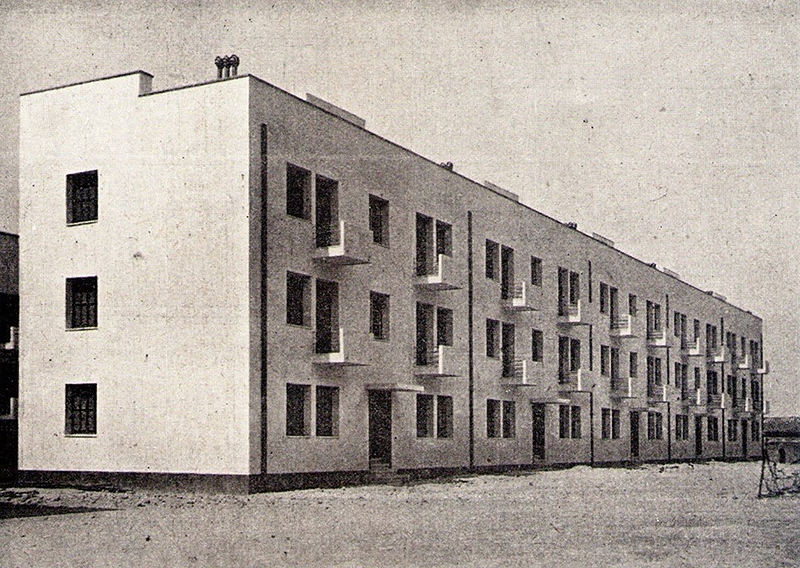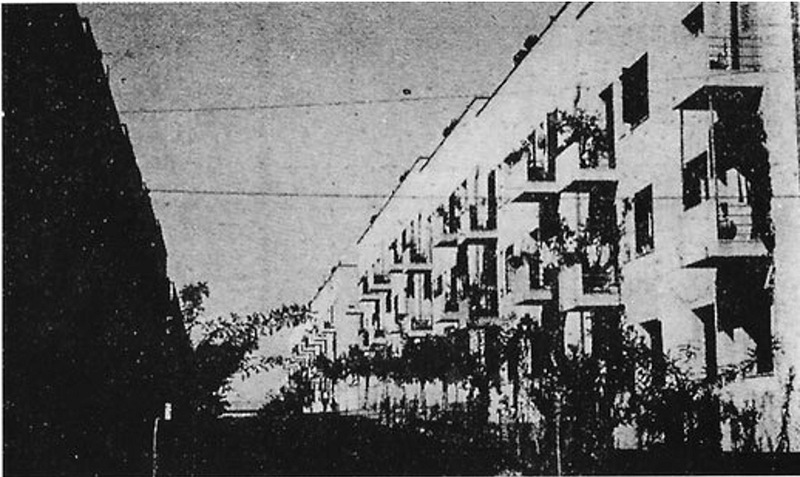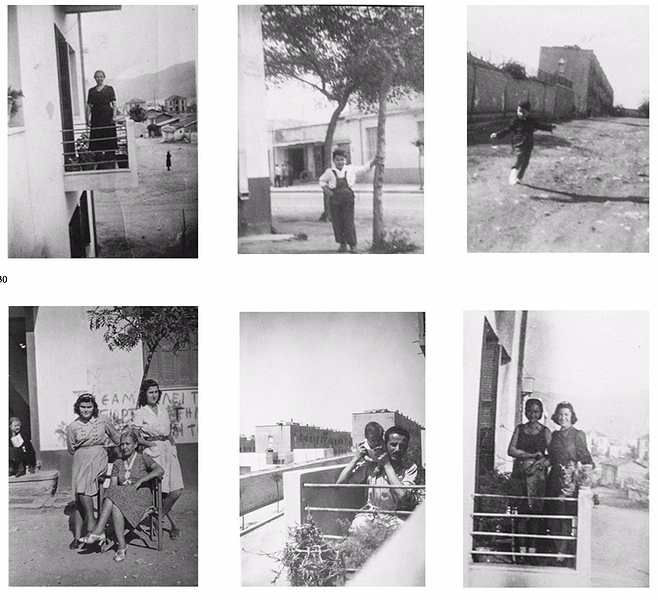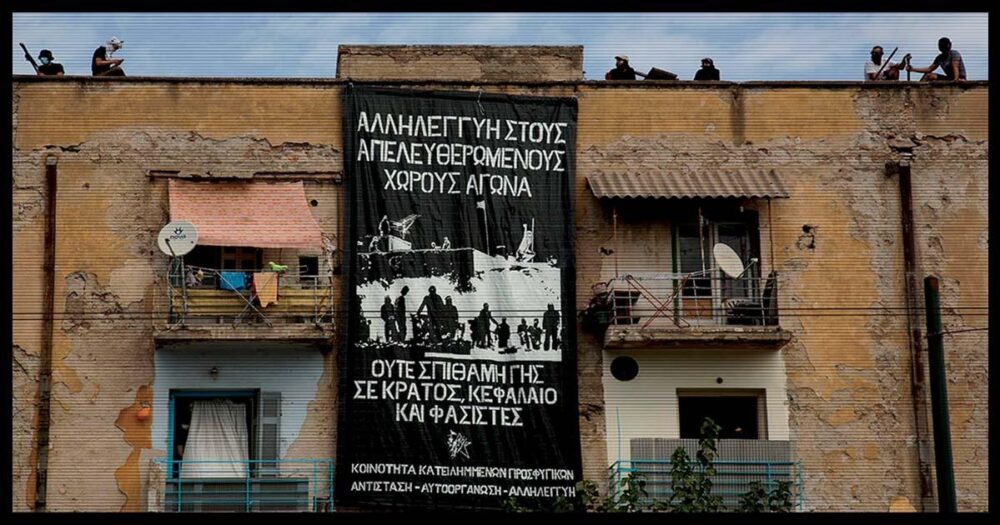COLLECTIVE MEMORY, RESISTANCES AND OUR OWN HISTORY
In the conditions of the social struggles that took place during the period 2008-2010, some of the squatters that we lived in the neighborhood of “Prosfigika” realized that the collectivization was the only solution for us. Firstly because of the architectural structure of the area which is designed for community life and secondly because we were suffering from micro-mafias that were looting the spaces. Since then, several solutions have been provided based on self-organization and also on problems that had to do sometimes with subletting, sometimes with drug trafficking and child sex trafficking. As an assembly that was oriented towards the ideals of communal ownership and perceived the value of use as the only value, we created “community of squatted prosfigika” (SY.KA.PRO) in 2012.
Today, most of the neighborhood is occupied and inhabited. During these 10 years we have managed to fill the neighborhood with life, transforming it into the largest squatting community (spatially and numerically) in Greece, with 400/500 permanent residents and self-organized structures (meeting place, children’s house, women’s structure, meetings with the initiative Ψ for mental health issues, community coffee, children’s cinema, community cuisine, community ovens, gym, community center, 2 houses of internationals, distribution of food from neighboring public markets, community internet, equipment for cleaning the sewerage and language lessons).
We do not see our project as an “island of freedom”, nor do we have such illusions. We are part of the class, social and international struggles and we perceive self-management and self-organization as the only way against the state and capitalism. Prosfigika neighborhood is a practical response to the social and economic conditions that have been forced to us. Our community is a home to people from all the spectrum of repression : war refugees, political refugees from Turkey and Kurdistan, migrants, families with children, elderly, sick, homeless, LGBTQI, former drug addicts, political activists, anarchists , communists, people of all nationalities and religions, a cultural mosaic of repressed class.
The land where “prosfigika” was built (covering an area of 14,500 sq. m) was under conflict
between the refugees that were kicked out from minor Asia (they were living there in tents already) and football fans. The fans of the newly formed Panathinaikos football team (the team was about 15 years old) were claiming the land for which they had already given money to the Greek state.
Fights started between the refugees and the fans and finally the state intervened and gave the opposite land to build the stadium in 1933-1936. So the neighborhood was built as a complex of 228 apartments of 50 sq. m which were bought under favorable terms by the refugees, mainly from the Turkovouni camp.
Over the years, the state has repeatedly threatened to suppress the historic neighborhood. The junta was the first to issue a ministerial decision according to which the first 4 rows of houses would be demolished to build the Courthouse, a plan that finally did not move forward. Rumors of demolition and gentrification of the area continued for the following decades. In 1994 the (DEPOS) Public Company for Urban Planning and Housing proposed the renovation of 2 apartment buildings as a pilot project and then to continue with the rest, another plan that didn’t succeed. Finally, in the late 1990s, the decision was made to demolish the historic neighborhood in order to become a mall, an underground garage and to be integrated as a Panathinaikos stadium extension.
Thus, the (KED) State Real Estate Company presented and offered 25,000 euros in order for the residents to leave. If they refused they would lose their homes as the state would proceed with forced expropriation. The residents initially refused and the amount rose to 50,000 euros, while the objective value was estimated to be 75,000 euros. Until 2003, the state, under suffocating pressure, managed to evict most of the residents by practicing all the legal terrorism allowed since its establishment, and 177 apartments were transferred to the KED. 51 residents refused to give in terrorism and with the support of the School of Architecture appealed to the (STE) Council of State and after two court rulings, in 2003 the two front rows were declared a “newer monument” as belonging to the Bauhaus movement and also carry up to today the signs from the fire received by the left forces during “Dekemvriana” * (It is surprising, of course, that an entire state was unaware of the building’s historical value).
In 2009, a year when the other 6 rows of houses were also designated as newer monuments, the (TEE) Technical Chamber of Greece requests the exchange of one of its own plot (the current Navarino Park in Exarchia) with 4 of the refugee apartment buildings in order to relocate headquarters of the Chamber and its library. The plan was not implemented. In 2014, 137 houses were transferred to the Public Private Property Utilization Fund (HRDH) and in 2016, the 177 apartments are transferred to the Attica Region. In 2018, the Council of State allows the re-transfer of the 137 apartments to the HRDH and the Supreme Court of Cassation rejects the application of the Municipality of Athens, which claimed ownership of the property. In the same year, ANAPLASI SA was founded with Belavilla as president and the Syriza government announcing a European-style
redevelopment of the refugees with a charity wrap and a museum exhibit. In 2019, the studies carried out with an individual donation (Hellenic Petroleum-ELPE) were granted to the Region and were put to public consultation. Today, while all the houses have been judged to be sustainable, the latest from the current government is the signing of a memorandum in December 2020 for the double renovation of the Botanical Garden and Avenue between Eleonas GDP (Alpha Bank & Piraeus Bank), the Municipality of Athens, Attica Region and ANAPLASI ATHENS SA, with Bakoyannis as Chairman of the Board, with unclear intentions for the “regeneration” as they stumble upon legislative road problems and unclear provisions on how to intervene on a monument. So they focus on the timeless project for the underground garage and the construction of a mall in place of the Panathinaikos stadium.
As it is obvious, from the constant transfers of property status and ambitious plans that are
announced from time to time, Prosfigika have become a ball in the various government services and everyone wants to “save” them from decadence as they claim, while the reality clearly shows us, that the state is the main aspiring corruptor of the collective memory of the refugees, as well as the mediator for all kinds of businessmen who see the space as an chance for profit. Putting forward, as a Trojan horse, the need to house the accompanying patients of St. Sava, the need for a refugee museum or the need to house vulnerable groups, they shamelessly underestimate our intelligence. The “Christian Union”, which belongs to the Petraki Monastery, is the owner of the plot and the building facilities of Ag. Savva, and his invisible but general commander. It has entire buildings in the wider area that could very logically allocate for the needs of the hospitality of the accompanying patients of Ag. Savva, which of course he rents or leaves abandoned until he exploits them. As for the need for a refugee museum, not even the most conscientious can be convinced of their real intentions.
Prosfigika is a living organism and an integral part of the broader radical social movement. It is a shelter – home for refugees who survived the modern imperialist wars and fascist regimes. As a community consisting of refugees participating in modern social struggles, they can be described as a “living museum” without the approval of official bodies. The associations of “Asia Minor”, being descendants of refugees themselves, should ask themselves, how many refugees currently live in the apartments and whether the need for housing is superior to a museum. As for the vulnerable social groups for which the state is concerned, let us inform them that the majority of the inhabitants today belong to those groups. We are not convinced by the charitable policies of either the current or the previous government. By deconstructing the social profile of the gentrification, we should examine the cancelling of “ESTIA” program, the general management of the migration issue, the abandonment and disuse of dormitories and the pre-planned full privatization of health and education. It is the state that creates the housing problems for vulnerable social groups and will no problem can be solved with Prosfygika gentrification. Let’s not forget, Prosfygika gentrification plan is another “game” that public money are being used by mayors, contractors, businessmen etc.
At the same time, in the case of Prosfygika, the state shows that it seeks to become a regulator of collective memory and that the main purpose of mayors and government officials, in addition to profit, is to seize the political overvalue that the gentrification will produce in order to satisfy the mainstream and trendy reflexes of modern metropolitans.
The “blur” caused by modernization and spectacle in the metropolitan centers is well known:
futuristic works of art, Airbnb, expensive shops, restaurants and bars, offices of first-class
companies, inhospitable parks, “smart” events in the streets of the center, for loafers and tourists, bypass the systematic degradation that comes before the seizure of public space, the expulsion and repression of natural residents and resistance movements. A city’s centre without inhabitants remains defenseless and at the mercy of businessmen, visitors – consumers and tourists. Without the natural relationship between people and places there is no chance of defending them. Some typical examples are the ones of Barcelona and Berlin where the inhabitants were expelled in the suburbs and any way of life inside the centre is connected exclusively with entertainment and consumption.
Although in the advanced West, the attack of capitalism escalated in the 80s with the privatization of natural resources, public spaces and social services, in Greece that happened when the memorandums came. A crucial point for the development of modern capitalism in Greece was the 2004 Olympics, where it forged the conscience of the average Greek to unconditionally welcome the attack of capital, served as modernization.
Through the suppression of movements and the degradation of living standards, not only locally but also globally, extreme neoliberalism is prevailing and being established. On the contrary, the battles waged by the local movements against privatizations, for the preservation of the natural heritage and public spaces as such, give rise to new dynamics and prospects to overthrow the domination.
The repression the squatters are receiving is the state’s attack on the most radical part of the competitive movement. It is an attack on the houses of the fight, on the liberated areas, on the practice of self-organization, on the hatcheries of the young fighters. It is a long war whose intensity fluctuates according to the dynamics and unity of the movement. On July 23, 2020, at dawn, the company “Anaplasi Athinas SA” drilled in the neighborhood to conduct research in the subsoil and was expelled as soon as it was noticed by the community.
Without fetishizing specific practices, our choice is the militant defense of the community. As an example during the Golden Dawn trial, when fascists and police launched a common invasion operation on 31 October 2016, we fought back. Of course the example of comrades from Koukaki community who militarily defended their occupations cannot be forgotten as well as the disobedience everywhere in the world. Facing the frontal attack of the state, we need to be organized with central planning and not to react to the events in urgent procedures. It is crucial that we coordinate ourselves as all the parts of the conflict, leaving behind the mentality of selective solidarity and kinship groups. We need open processes aimed at our political and physical continuity, the recapture of liberated areas, the territorialization of struggles, and the introduction of a new world in our processes.
There is a need to create an attica central coordination with a common strategy, with strong bonds of solidarity to claim the free and liberated spaces and to strengthen the local struggles with our physical presence. We have made the decision to stay, to fight and to stand up for our homes, for our community, for another liberated place, and we will do so until the end.
HISTORY OF ΟUR NEIGHBORHOOD
The past and present of Prosfygika shows the struggle of the workers and the persecuted. Those who have never found solid ground to stand on, and those who never ceased to fight. One can hear the ringing of guerilla machine guns and the guerrilla riders that sound from home to house through bullet holes that punctured the walls during the December 1944 uprising. Nights are filled with the screams of the tormented political prisoners of Averoff Prison and the cry of the ruins of demolished buildings. We are suffocating today, with the new tyranny imposed on us and the threat of violence and barbarity expressed by the two symbolic monsters of sovereign power, the gangs of violence and repression that lay siege to us: GADA (Police Headquarter) and the Court of Appeals
In Prosfygika, Alexandras Ave., there are currently more than five hundred people from every manifestation of the oppressed class: Refugees, immigrants, families with their children, the elderly, the sick, formerly homeless, political fighters, addicts, those dependent to the ELPIS hospital, and people of every nationality or religion. It is a multinational mosaic of the communities of the world’s most rebellious and plundered of peoples. People who have experienced capitalist war, displacement and torture, poverty and misery, persecution and hunger.
Our narrative about the neighborhood of Prosfygika speaks to the struggle for survival and dignity, for solidarity and companionship, for self-organization, equality and social struggle, for interracial and inter-religious coexistence in times of poverty and social cannibalism. A social and cultural workshop of self-esteem and community that continues to remain with those who built it, immigrants, refugees and opponents of capitalist barbarism. It talks about the smiles of dozens of children playing in the streets of the neighborhood, collective kitchens and self-organized production and self-education structures, social and political actions, care for the sick and the weak, maintenance work, with meager means, a place that concentrates memories of struggles of the working class over the past eighty years.
Genius Prosfygika Loci
We are not alone here. Our struggle to keep #Prosfygika alive, livable and lively is the continuation of the struggle that lasts almost a century now. This is just a handful of pictures, showing how Prosfygika started and how the community lived through decades of extremely “interesting times”. We, here and now, just carry the torch. We fight the battles that are new and old at the same time. Our colors are more black than red or white-blue, but our enemies are the same: enemies of humanity, enemies of freedom, enemies of history.In brown uniforms, in riot gear or business suits, their aim is the same. And Prosfygika always stood in their way.
Coordinated effort of dedicated people saved Prosfygika from being bulldozed during Olympic Games frenzy. Here we see painted screens intended to hide “abomination” from the eyes of illustrious quests.
Olympic Games 2004 become the starting point of gigantic financial scam, currently known as “the Greek debt crisis”.

1920s’ style modernist blocks were built in the middle of arable land. Way before the brutalist neighbours flanked the district.
This is good architecture. well designed flats, suitable for Greek climate. Whatever survives from these years (at least infrastructure-wise) shows good quality and craftsmanship. No skimping.
Very soon, thanks to the commitment of the residents, Prosfygika became a living garden.

There is a bigger gap between blocks 2 and 3, apparently designed as a local plateia. Overall distance between blocks provides enough sunlight for everyone in the winter and enough shadow in the summertime.

Life in Prosfygika. The wall (bottom-center) was probably the Averof Prison. Prosfygika dwellers used to help the inmates (especially during the era of the fascist junta governments of Greece).
Averof Prison was an infamous central prison facility in Greece. See also The Six Executed from Dmbeni .

During the German occupation and later, the Civil War, Prosfygika was actual stronghold of antifascist resistance. Whole community was involved, sheltering the fighters, building secret passages between the flats.
Bullet holes in houses’ walls later protected the neighborhood from being sacrificed at the altar of greed and soullessness.
Note US Army Jeep(?) at the bottom-left picture. This is the time of (relative) peace.
